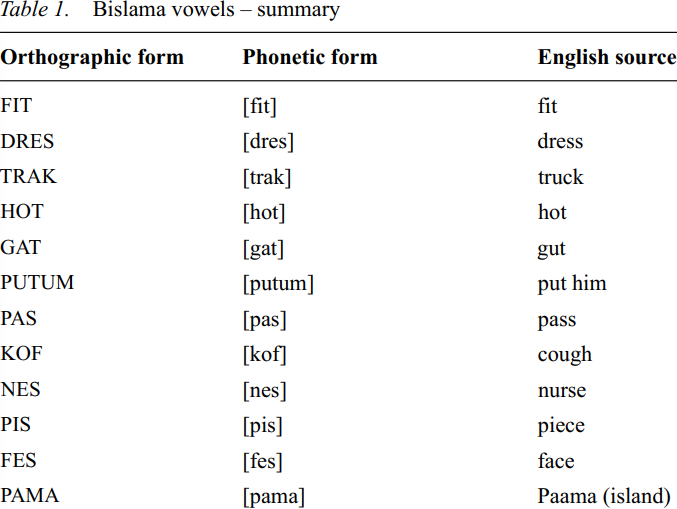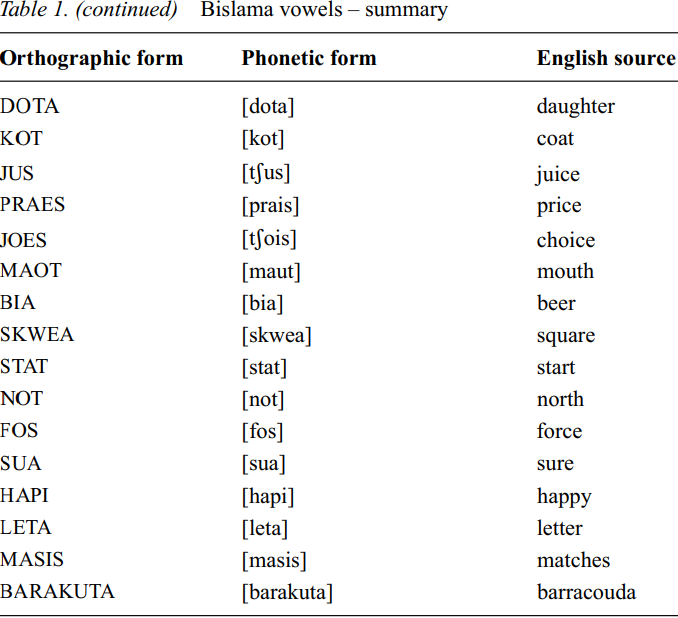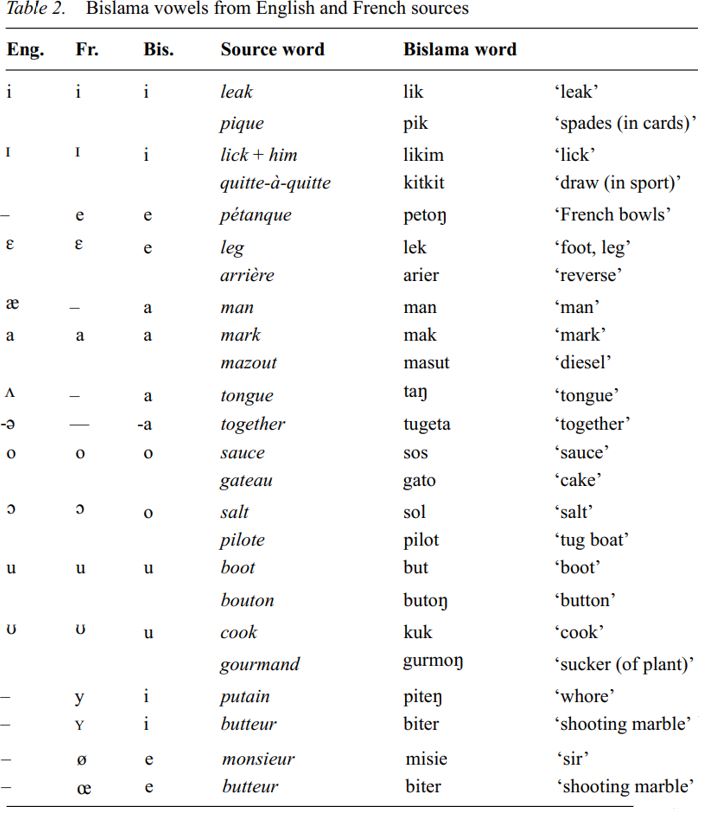
Phonemic contrasts and phonetic realizations Vowels
 المؤلف:
Terry Crowley
المؤلف:
Terry Crowley
 المصدر:
A Handbook Of Varieties Of English Phonology
المصدر:
A Handbook Of Varieties Of English Phonology
 الجزء والصفحة:
676-38
الجزء والصفحة:
676-38
 2024-04-26
2024-04-26
 1343
1343
Phonemic contrasts and phonetic realizations
Vowels


Bislama is usually described as having the following five-way vowel contrast (with no phonemically contrastive length):

These segments have phonetic values that correspond closely to the cardinal IPA values, with little observable allophonic variation. There is a tendency for rural or lesser educated speakers from the island of Tanna to phonetically lengthen a stressed vowel in a disyllabic word, and to reduce an unstressed vowel in a closed final syllable to a high central vowel, resulting in alternations for a form such as /apol/ ‘apple’ as [ápol] and [á:pɨl]. Such pronunciations, however, are strongly stigmatized, and their appearance seems to be exaggerated as a result of stereotyping.
As with the consonants, there are some fairly regular correspondences between the shapes of Bislama words and their corresponding English or French etyma, with substantial reduction in the number of contrasts between English and Bislama. English /a:/, /æ/ and /Λ/ , for example, regularly correspond to Bislama /a/, e.g. /mak/ ‘mark’, /man/ ‘man’, /taŋ/ ‘tongue’. New words are constantly being incorporated into the language from English and French by generalizing on these correspondences. This is not to say, however, that the forms of Bislama words can be unfailingly predicted from the shape of an English word. There are substantial numbers of unpredictable shifts such as /talem/ ‘tell’ (rather than /telem/), /rusum/ ‘roast’ (rather than /rosem/) and /flaik/ ‘flag’ (rather than /flak/). The most regular patterns of correspondence between English and French vowels on the one hand and Bislama vowels on the other are set out in Table 2.


It should be noted that non-final central vowels tend to be fairly unpredictably reflected in Bislama as /o/, /e/, /i/ or /a/. We therefore find English etyma such as the following where /з:/ is reflected invariably as /o/: /bon/ ‘burnt’, /wok/ ‘work’. In /tanem/ ‘turn’ it is reflected invariably as /a/, in /gel/ ‘girl’ it is reflected as /e/, while in the word for ‘shirt’ it is reflected variably as /set ~ sot/. Non-final schwa also often varies between /o/, /e/ or /a/, as in /ofisol ~ ofisel ~ ofisal/ ‘official’.
Words in English containing diphthongs beginning with mid vowels and ending in a high vowel of the same value for frontness and roundedness tend to be somewhat variable in their Bislama reflexes. Word-medially, such diphthongs are generally reflected simply as mid vowels with no off-glide, e.g.

Word-finally, there is rather more variation between monophthongal and diphthongal reflexes in Bislama, e.g.

Word-final diphthongs beginning with a mid vowel and having a schwa offglide – corresponding to post-vocalic /r/ in rhotic dialects of English – also vary in their Bislama reflexes between a simply mid vowel and sequences of /ea/ and /oa/, e.g.

 الاكثر قراءة في Phonology
الاكثر قراءة في Phonology
 اخر الاخبار
اخر الاخبار
اخبار العتبة العباسية المقدسة


